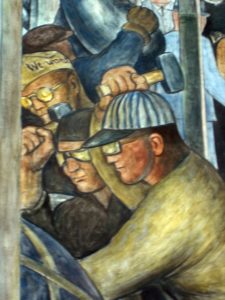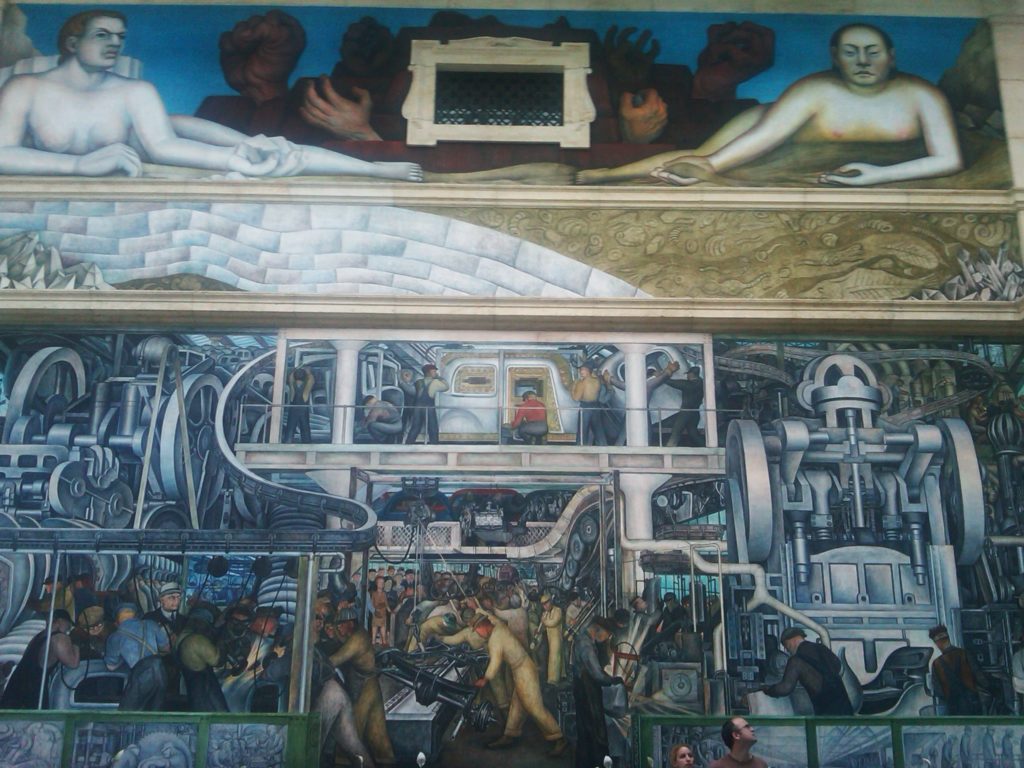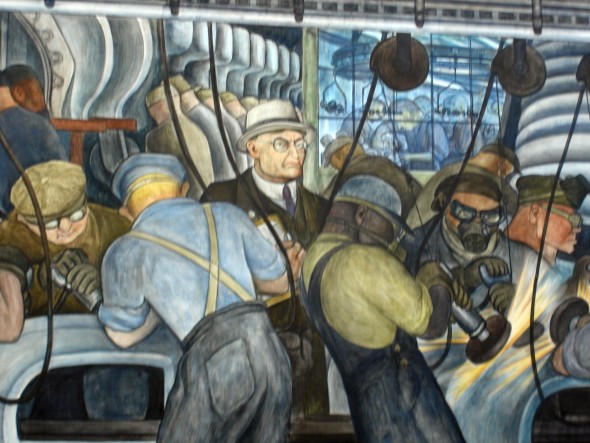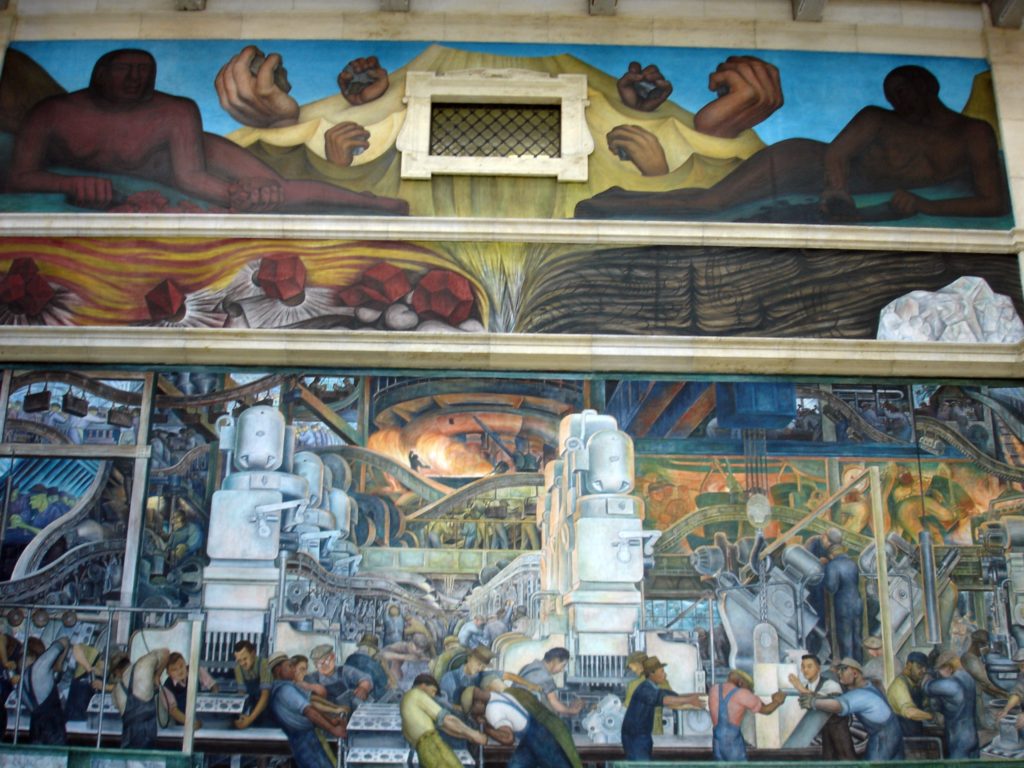Viewed today, “Detroit Industry” murals by Diego Rivera might have prefigured Detroit’s downfall, but also envision a renaissance. It harkens to the Earth, the races living and working in harmony, where sections of the city has been cleared of distressed neighborhoods and allowed to regrow with food crops, grasses and trees.


Detroit Industry Murals: The Divergent Visions of Diego Rivera and Edsel Ford
Mexican artist Diego Rivera’s masterful Detroit Industry (1932-33), frescoed on the walls of the Rivera court at the Detroit Institute of Art (DIA), displays the city’s history as integrally tied to the rise and fall of technology and industrial mass production of the steel age.
The work draws connections to the four races and earth elements, symbolically questioning the church, capitalism, and the ruling class with humor and fearlessness. It would seem the mismanagement and excesses of the industrial economy and orientation toward corporate profits and militarism, alluded to in a number of the panels, has proven the downfall of the once-towering economy of Detroit. What’s not good for General Motors, so the saying goes, is not good for the United States.
STORY: Revitalizing Detroit One Hive At A Time with Detroit Hives


Viewed today, Rivera’s magnum opus might have prefigured Detroit’s (and the USA’s) downfall, but also may envision a renaissance. It hearkens to the Earth, the races living and working in harmony, as is seen where much of the city has been cleared of slums and allowed to regrow with food crops, grasses and trees, with a number of urban farming cooperatives to foster a new economy based upon a sustainable view of the environment.
“I admire Rivera’s spirit. I really believe he was trying to express his idea of the spirit of Detroit.” — Edsel B. Ford
Commissioned by Edsel B. Ford (son of Henry, arts patron, and head of Ford Motor Company at the time) and directed by William Valentiner of the DIA, the frescoes are a series of 27 panels. They depict operations at Ford as well as medical, pharmaceutical and chemical industries related to the history of Detroit and its people. Yet the story is complex and (at the time) seditious, and must be decoded frame-by-frame to unveil a bold alternative vision presented in the face of Rivera’s benefactors.
STORY: Popol Vuh: The Ancient Maya Dawn of Life and Overcoming the Forces of Awe


Symbolism: US Industry and Mytho-Historical Earth Origins
The murals, considered by Rivera as one of his most successful works, juxtapose bright earth colors and post-impressionistic simple forms against the smoke-churning machine-life of drab Detroit in the storytelling manner of Maya stelae. Celebrating creation and destruction through science, medicine, and technology, Rivera blends Earth and sky deities, human and machine power, healing and poisoning, war and peace. He also captures the assembly-line automatonic intensity and a revealing tension between the factory workers, towering machines, and the stern managing overseers.
Massive figures of the “Red and Black Races” and “White and Yellow Races” reflect Rivera’s grand inclusive vision, with references to their correlative geological strata, iron, coal, limestone, and sand, indicating connection between steel and raw materials of the earth’s natural processes.
Rivera’s frescoes on the West Walls of the court are most telling, contrasting positive aspects of the aviation and chemical industries, where planes flew like doves through the world and science discovered new products to improve commerce and humanity. This compared with war planes, attacking like a hawk, spreading poisoning mustard gas, employees and pilots needing gas masks just to breathe. The will to militarism is a key indictment of Detroit Industry, then and today.
STORY: Matthew Power: Detroit Shall Rise Again


Marxist, Anti-Religious Propaganda or Art?
Rivera’s radical political beliefs, attacks on the church and clergy, as well as his dealings with Trotskyists and left-wing assassins, made him a controversial figure even in Communist circles. Critics viewed his race- and class-aware DIA murals as Marxist propaganda. Some considered the creation vulgar and slanderous to the working class. Certainly it questioned the ruling class, and some even used the always familiar term “Un-American.”
Rivera depicted certain Ford managers, a composite of Henry Ford and Thomas Edison, and the head of Detroit’s Parke-Davis pharmaceutical company as angry or mad task-masters. In another panel, a bourgeois and superfluous tour group humorously were rendered as cartoon characters such as Charlie Chan and Dick Tracy. Other times workers are portrayed as suffering from toxic effects and others with Communist symbols such as gloves adorned with a red pentangle and wielding a sledge-hammer.
Catholic and Episcopalian clergy condemned the murals for supposed “blasphemy” due to his depiction of the Medical-Nativity scene as a halo-adorned baby (“Jesus”) vaccinated by a nurse (“Virgin Mary”) and a doctor (“Joseph”) amid sheep (“Lamb of God”) and oxen and a horse (donkey), backed by three scientists of varying race (“three wise men”) dissecting a dog (in the name of science, of course). Calls were made to destroy the work.
In the end, both Edsel Ford and the museum stood behind Rivera and his masterpiece. Ford only issued a simple statement, “I admire Rivera’s spirit. I really believe he was trying to express his idea of the spirit of Detroit.”
photography by Jack Eidt, technical assistance thanks to Jessica Aldridge
[cincopa AsPAlv6Gu94_]
This piece was also featured on CounterPunch
Updated 25 June 2021









Pingback: Detroit's Sprawling Legacy: How to Overcome the Automobile | WilderUtopia.com
Pingback: Detroit Future: Landscape Urbanism, Antidote to Industrial Blight | WilderUtopia.com
Pingback: Greening Detroit: Positive Change Moves Slow and Fast | WilderUtopia.com
Pingback: Painted Sugar Skulls on Dia de los Muertos | WilderUtopia.com
Pingback: Painting Murals On Walls | empluk.co
Pingback: Revitalizing Detroit One Hive At A Time with Detroit Hives
Pingback: Detroit Hives: Honey Bee Farms as Urban Revitalization